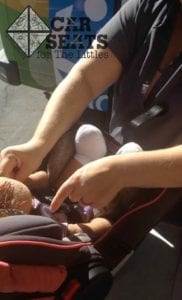Why We Do What We Do
When a caregiver rolls into a car seat check event or up to a private seat check appointment, as CPSTs, we’ve got a few luxuries built into the interaction. We can look the caregiver in the eye and gauge how receptive they are to the best practice information we’re providing. As we start to pull their child’s seat out of the car to check for recalls, we can see if anything we’re saying about extended rear facing, extended harnessing, or boostering beyond the minimums is making that caregiver defensive or upset and change tactics a bit to help get our message across.
During that first conversation, we can often determine how willing the caregiver is to learn about their child’s seat, or if they’re hoping that we’ll just install it for them. Spoiler: in most cases, we won’t. We’ll do our best to teach the caregiver how to install the seat themselves, working around any limitations the caregiver might have.

Low cost seats
Sometimes, the coalition or organization we’re working with at the event has low-priced program car seats at our disposal during an event to sell to caregivers who come in with expired, crashed, or inappropriate seats. Being able to provide those is a great service to the community.
Online Help
When we’re working with caregivers online doing the kind of virtual seat check event that is the core of what we do here at Car Seats for the Littles, we lose those subtle means of interaction that are such a help in person. We can’t look a caregiver in the eye, we can’t interpret how interested they are in our message of best practice. We also can’t force them to read a single word of the resources we’re able to provide.
Over time, we’ve learned a good many lessons around this type of interaction. We’ve learned that, to a point, more words are required. While the short answer might be “that’s not safe,” the longer answer of “those lovely aftermarket strap covers you’ve got there weren’t crash tested with your child’s seat so we can’t say for sure how they might interact with the seat during a crash” explains the situation a bit more clearly. So we try to provide caregivers with the longer, more accurate replies.
At the same time, we’ve got a large number of well-intentioned members of our group and followers of our page who reply right away with the shorter answer. While accurate, almost every time that shorter answer leads to hard feelings or defensiveness that could drive a caregiver away from using us as a resource.
And that’s the last, absolute last thing we want to have happen. So we try to educate all of our advocates about the types of approaches that we’ve learned are the most effective.
Because we want to inspire every caregiver who crosses our path to read their child’s car seat’s manual, to become an expert on that seat especially when it comes to their child riding in that seat.
Tough Choices: In Person
At an in-person event, there’s a little more gray area when it comes to best practice. Some cars come in with every child in an expired seat, some children in no seats at all, some or all seats installed incorrectly. With each car that we dive into, we do our best with the tools we’ve got available to make every child safer than when they arrived. That can involve compromises that we wouldn’t make for our own children. It can mean choices between a rock and a hard place, scenarios that we don’t encounter online, and budgets that just don’t support best practice.
We work hard to make every child who comes into a seat check safer than when they arrived.
Tough Choices: Online

Even Whippets care about car safety!
As technicians, we are taught to educate the caregivers. If there is a tough decision to be made, we do not make it. It is the caregiver’s job to make those choices.
Interacting with caregivers online, that distinction isn’t as obvious. We present the best practice information online. The caregiver then makes the choice to incorporate our advice into their situation, or not. We do not advocate for anything other than best practice, but the caregiver makes the final choice.
Online, we’re able to advocate consistently and a bit relentlessly for best practice. We do this for a couple of reasons: first, because we can. We’re not standing in a parking lot on a rainy day, trying to convince a caregiver that their 18 month old should be rear facing when the law and the car seat’s manual have a 1 year minimum. We’re interacting with you from a comfortable place, where we can look up resources to support everything we’re saying.
We’re also putting our advice in writing. Once written down, other caregivers can reference the advice we’re giving and if we’re not careful, interpret it in a different way than we intended.
So we work hard to be clear, confident, correct, and compassionate in the words we use online.
Caregivers hearing our message is our primary goal.
The Law vs. Best Practice

California Pamphlet (pre-2017)
At times, the law and other government organizations set minimum safety guidelines that fall below the marker of best practice. As an advocacy organization, CSFTL is fortunate — we can advocate for best practice whenever possible, even when the current law falls short of that best practice.
Given this unique platform, we’re able to adopt and adhere to the following best practice guidelines:
- We maintain that children under two should be rear facing, even though it is not illegal for a one year old to forward face in most places, and even though it is actually illegal for a one year old to rear face in some places.
- We maintain that boosters are for children ages 5 and up and not four or three years old, no matter how the seats are marketed. We would never, ever advocate for, or permit a recommendation for, for example, a Harmony Backless booster for a 30 lb 38″ two year old, no matter how technically legal it is.
- We maintain that all forward facing seats should be top tethered, 100% of the time, and that this means, sometimes, rearranging a car in a way that is not particularly convenient for the caregiver.
- We maintain that children need boosters well beyond the traditionally accepted age of 8, an age which does not correspond to any of the actual, known markers for seat belt readiness.

Seat Check Event
We understand all too well that the difference between an online discussion and a real-world seat check event is the ability to work within the gray area between best practice and improved safety for all passengers. This is why we always recommend parents and caregivers seek out a CPST for hands-on help in tricky situations.
While parents ultimately make the final decisions regarding seats for their child, our goal on the forum is to make sure we are providing education and resources in line with best practice recommendations so that all caregivers following can make their decisions with those guidelines in mind.


